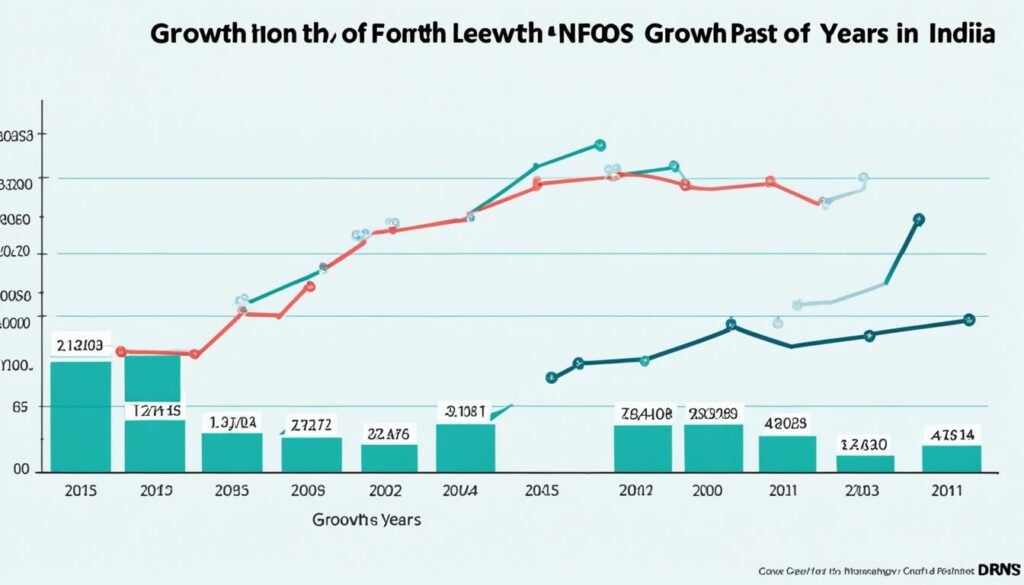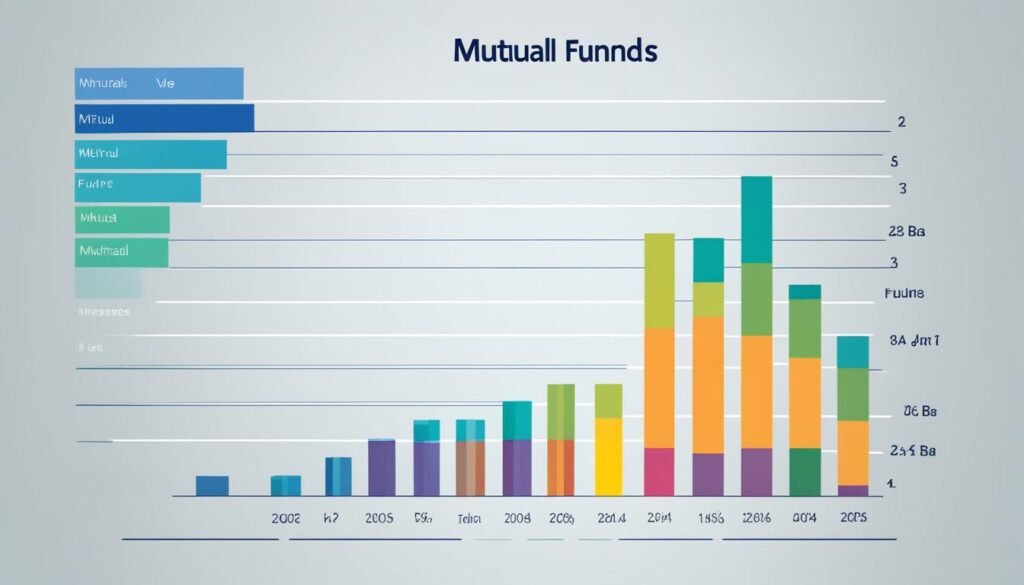In the last two years, the mutual fund industry in India has seen a big jump in new fund offerings (NFOs). About 117 NFOs were launched in 2024. Now, 94 mutual fund schemes are open for investment, giving investors many choices. These NFOs have shown strong performance, with some schemes giving great returns since they started.
Tata Gold ETF and Tata Silver ETF have been in the market for about 171 days. They have given returns of 14.09% and 22.08% respectively. Zerodha Nifty 1D Rate Liquid ETF, in the market for around 166 days, has returned 2.99% since its start. Four mutual funds – Tata Gold ETF FoF, Tata Silver ETF FoF, Bajaj Finserv Nifty 50 ETF, and Bajaj Finserv Nifty Bank ETF – have been around for 164 days. They have given returns between 13.7% and 21.3%.
Bandhan Multi Asset Allocation Fund and Mirae Asset Multi Asset Allocation Fund have been open for about 152 days. They have given 12.3% and 9.4% returns, respectively. Nippon India Nifty Bank Index Fund gave an 11.8% return, while Nippon India Nifty IT Index Fund lost 4.7%, both in 130 days.
Key Takeaways
- Around 117 new fund offers (NFOs) were launched in India in 2024, with 94 mutual fund schemes available for investment.
- Several NFOs have delivered impressive returns, with Tata Gold ETF and Tata Silver ETF offering 14.09% and 22.08% returns respectively since their inception.
- Diversified and sector-specific NFOs have shown promising performance, with Bajaj Finserv Nifty 50 ETF and Tata Nifty Auto Index Fund generating returns of 11.6% and 13.4% respectively.
- The mutual fund industry’s focus on launching new fund ideas has resulted in a variety of NFO options, catering to different investment objectives and risk profiles.
- Investors should carefully analyze the NFO’s objectives, fund management strategies, and expected returns before making an investment decision.
Introduction to New Fund Offerings (NFOs)
New Fund Offerings (NFOs) are when asset management companies (AMCs) launch new mutual fund schemes. These can be active or passive funds, open-ended or close-ended, and cover equity, debt, and hybrid assets. It’s important for investors to check out these new NFOs. This helps them see market trends, understand fund manager strategies, and see how new funds stack up against others.
Definition and Overview of NFOs
NFOs introduce new mutual fund schemes to the market. They give investors more ways to grow their money. These funds can be equity, debt, or hybrid, fitting different risk levels and goals. NFOs usually start at ₹10 per unit, making them easy for those with a small budget to get into.
Importance of Analyzing NFO Performance
Looking into the performance of new fund offerings is key for investors. It lets them grasp market conditions, fund strategies, and how these new schemes compare to others. By checking the fund performance analysis of NFOs, investors can spot top investment chances and spread out their fund categories.
| Key Statistics on NFOs | Value |
|---|---|
| Minimum Subscription Amount (Debt/Balanced) | ₹20 crore |
| Minimum Subscription Amount (Equity) | ₹10 crore |
| Minimum Investment by AMC | ₹50 lakh or 1% of NFO |
| Minimum Number of Investors | 20 |
| Maximum Holding by a Single Investor | 25% |
The table shows the main rules for new fund offerings in India. These rules make sure there’s transparency and protection for investors during the NFO process.

Performance of NFO Launched in Last 2 Years in India
The Indian mutual fund industry has seen a big increase in new fund offerings (NFOs) over the past two years. This time has brought a wide variety of NFOs, from funds focused on specific sectors to thematic funds. These funds have shown different levels of success.
Top-performing NFOs by Returns
The Motilal Oswal Nifty Realty ETF has been a big winner, with a return of about 31.9%. It has been in the market for 108 days. The HDFC Manufacturing Fund also stands out, collecting ₹9,563 crore during its NFO period. It now manages ₹10,345 crore as of May 2024, after just 46 days in the market.
Analysis of Asset Classes and Fund Categories
Out of 94 new funds in the last two years, sector-specific and thematic funds have done well. The Tata Nifty Auto Index Fund and the Tata Nifty Realty Index Fund have given returns of 13.4% and 13.5%, respectively. This shows the strength of these funds.
Also, 27 index funds and 24 ETFs were launched in 2024. These funds show different levels of success. This variety helps investors choose the right type of investment for their goals.
The varied success of these NFOs shows how important it is to do your homework before investing. It’s key to look at the asset classes, fund types, and how well they’ve done. This helps match your investments with your financial goals.

Comparison of NFOs vs Existing Mutual Funds
When looking at NFOs (New Fund Offerings) and established mutual funds, several key factors come into play. These include the fund type, investment strategy, market conditions, and how well they perform after adjusting for risk. Some new NFOs have done better than others in the same category. Others haven’t kept up with the returns of well-known funds. It’s important for investors to look closely at the goals, what’s in the portfolio, and the long-term performance of both NFOs and existing funds before deciding where to invest.
NFOs are the first public offering of a new mutual fund. They don’t have the same history as funds that have been around longer. This means NFOs can be riskier for investors. They might not have the same level of diversification or proven management as older funds.
| Metric | NFOs | Existing Mutual Funds |
|---|---|---|
| Investment Performance | Varied, as some NFOs have outperformed while others have underperformed | Generally more stable and predictable based on historical returns |
| Fund Returns | Potentially higher in the short term, but less reliable in the long run | Tend to be more consistent and reliable over the long term |
| Risk-Adjusted Returns | Can be higher or lower depending on the fund’s investment strategy and market conditions | Typically better due to more established risk management practices |
Investors should think about the risk and reward of both NFOs and existing mutual funds. They should consider their investment goals, how much risk they can handle, and how long they plan to invest. By doing this, they can make better choices and possibly improve their investment portfolio’s performance.
Factors Influencing NFO Performance
The success of new fund offerings (NFOs) in India depends on many things. This includes the state of the market and the economy. When the stock market goes up and investors feel good, some NFOs do well. But, tough economic times and a falling market can hurt these new funds.
The way fund managers work and the strategies they use are key to how well NFOs do. Things like how they pick stocks and manage risks affect the returns of these funds.
Market Conditions and Economic Indicators
Good market conditions, like rising stock prices or positive feelings among investors, help some NFOs. But, bad economic signs, like high inflation or rising interest rates, can make it hard for NFOs to do well.
Fund Management Strategies and Expertise
The strategies and skills of the companies behind the NFOs are very important. How they spread out investments, choose stocks, and manage risks can greatly affect the funds’ performance.
When looking at NFOs, it’s smart to check the fund managers’ past success, their investment views, and how they handle risks. This can help predict their long-term success.
Sectoral and Thematic NFOs
The mutual fund industry in India is seeing more sector-specific and thematic NFOs lately. These funds focus on certain industries or themes, aiming for high returns.
Performance of Sector-specific NFOs
Sector-specific NFOs have shown strong returns. For example, the Tata Nifty Auto Index Fund and Tata Nifty Realty Index Fund have given 13.4% and 13.5% returns, respectively. This shows the power of sector-specific fund performance.
Thematic NFOs and Their Returns
Thematic NFOs focus on themes like technology, consumption, or manufacturing. Funds like the Tata Nifty500 Multicap India Manufacturing 50:30:20 Index Fund and the Tata Nifty500 Multicap Infrastructure 50:30:20 Index Fund have given 11% and 10.2% returns. This proves the success of thematic fund returns.
The rise of sectoral nfos and thematic nfos shows investors want specialized funds. As the mutual fund industry grows, these funds will be key for diversifying portfolios and strategic planning.
| NFO | Category | Returns Since Inception |
|---|---|---|
| Tata Nifty Auto Index Fund | Sectoral | 13.4% |
| Tata Nifty Realty Index Fund | Sectoral | 13.5% |
| Tata Nifty500 Multicap India Manufacturing 50:30:20 Index Fund | Thematic | 11% |
| Tata Nifty500 Multicap Infrastructure 50:30:20 Index Fund | Thematic | 10.2% |
Passive NFOs: Index Funds and ETFs
The Indian mutual fund industry has seen a big increase in passive investment options. This includes index funds and exchange-traded funds (ETFs) in the new fund offerings (NFOs). These options are popular with investors who want low-cost, index-tracking investments to grow their portfolios.
Performance of Index Fund NFOs
Out of 27 index fund NFOs launched in 2024, many have shown strong performance. Some schemes have given returns between 11-15% since starting. These funds are attracting investors because they track their benchmarks well, offering stable returns.
ETF NFOs and Their Returns
There have been 24 new ETF NFOs in the market. Some, like Nippon India Silver ETF and ICICI Prudential Silver ETF, have gathered over ₹100 crore in their first month. This shows investors are interested in these low-cost, passive investments.
These passive NFOs, including index funds and ETFs, are becoming more popular in India. They are part of a trend towards low-cost, index-tracking investments. This is helping investors diversify their portfolios.
| NFO Type | Total AUM (₹ lakh crore) | Number of Folios (crore) | Performance (1-year) |
|---|---|---|---|
| ETFs | 7.79 | 1.88 | 11-15% |
| Index Funds | 2.43 | 0.76 | 11-15% |
Passive NFOs are getting more popular in India. The share of equity mutual fund schemes has jumped from 27% in March 2013 to 62% in March 2024. ETFs and Fund of Funds (FoF) have also grown, from 2% to 13%. This shows a big move towards passive investments.
Asset Management Companies and NFO Launches
In India, the mutual fund industry has seen a big jump in new fund offerings (NFOs). Last year, 149 new schemes were launched, up from 117 the year before. This shows how asset management companies (AMCs) are working hard to offer more products to meet investors’ needs.
Top AMCs by Number of NFO Launches
AMCs like ICICI Prudential Mutual Fund, SBI Mutual Fund, and Mirae Asset Mutual Fund are leading in NFO launches. They use different strategies to make their NFOs stand out. They focus on market trends and what investors want.
AMC Strategies for NFO Launches
These top AMCs use several strategies for NFO launches. They include:
- Sector-specific NFOs to target investors with specific goals
- Thematic NFOs for emerging themes and trends
- Passive NFOs like index funds and ETFs for low-cost, diversified investments
These strategies help AMCs stand out, draw in more investors, and offer specialized investment solutions. This is key in the growing Indian mutual fund industry.
The increase in NFO launches shows the industry’s growth and its effort to meet investors’ changing needs. As the mutual fund market changes, AMCs’ strategic NFO offerings will be key to the industry’s future.
Regulatory Landscape and NFO Approvals
New mutual fund schemes, like New Fund Offerings (NFOs), must follow SEBI’s rules. SEBI is India’s capital markets regulator. It checks if the schemes meet the needed standards and protect investors.
SEBI Regulations on NFO Launches
SEBI’s rules shape the NFO market. They decide what funds can be launched, their investment strategies, and what info investors need. Key SEBI rules for NFO launches are:
- NFOs usually cost about Rs.10 per unit during the NFO period.
- SEBI says an NFO can open for up to 30 days.
- New Fund Offers must raise at least Rs. 20 crore for debt and balanced hybrid schemes and Rs. 10 crore for others.
- SEBI rules say at least 20 investors must contribute to an NFO, with no one investing more than 25%.
- The fund house launching an NFO must invest in it. This investment was once required to be at least 1% of the NFO amount or Rs. 50 lakh, whichever is lower.
These rules make the regulatory landscape for NFO approvals clear. They help make the SEBI regulations on fund launches in India clear and protect investors.
Investor Behavior and NFO Subscriptions
The success of New Fund Offerings (NFOs) in India depends on how investors behave and how much they subscribe. Many things can affect how much interest and money goes into these new funds. These include market feelings, news coverage, investment trends, and how unique the NFO seems.
Recently, more retail investors have shown interest in NFOs, even the riskier ones. This is because of market optimism and a wish to make the most of new funds’ growth potential. Investors like the chance for higher returns, but remember, past success doesn’t mean future wins.
Factors Influencing Investor Interest in NFOs
- Market Sentiment: When the market feels good and people think there’s growth ahead, more investors are likely to look at NFOs.
- Media Coverage: A lot of news about an NFO can make more investors want to join in and subscribe.
- Investment Trends: Investors might pick NFOs that focus on new themes or sectors, like tech, green investments, or new types of assets.
- Differentiation: NFOs that stand out with a special investment plan, mix of assets, or portfolio setup can grab more attention and subscriptions.
Knowing what makes investors choose NFOs is key for asset management companies (AMCs). They need to understand these factors to make their marketing and sales plans work. This helps them make their new funds successful.
Risk Management in NFO Investments
Investing in New Fund Offerings (NFOs) can be tempting but comes with risks. Managing these risks is key. Diversifying and rebalancing your portfolio are important steps for NFO investors.
Diversification: Mitigating Concentration Risks
Spreading your investments across various asset classes and managers helps reduce risks. This way, you’re not putting all your eggs in one basket. It makes your portfolio less dependent on one NFO’s performance.
Portfolio Rebalancing: Maintaining Optimal Allocation
Rebalancing your portfolio regularly is a must if you have NFOs in it. It keeps your investments in line with your risk tolerance and financial goals. This ensures your portfolio stays on track for the long term.
| Risk Management Strategies | Benefits |
|---|---|
| Diversification | Mitigates concentrated risks associated with any single NFO |
| Portfolio Rebalancing | Maintains optimal asset allocation and risk profile |
Using these strategies, investors can manage the risks of NFOs. This approach can help you make the most of these new investment chances.
NFO vs SIP: Investment Strategies
Investors in India can choose between New Fund Offers (NFOs) or Systematic Investment Plans (SIPs). NFOs might offer quick gains, but SIPs help with steady growth over time. They also make investing easier with dollar-cost averaging.
It’s key for investors to think about their goals, how much risk they can take, and when they plan to cash out. Knowing about NFOs and SIPs helps investors pick the right strategy for their money goals.
Lump-sum Investment in NFOs
Putting money into NFOs all at once can be good for those who want big short-term gains and aren’t afraid of risk. NFOs let you invest at a set price at first, which could lead to more money later as the fund grows.
Systematic Investment in NFOs through SIPs
Using SIPs for NFOs brings the perks of dollar-cost averaging and staying disciplined. By putting in the same amount regularly, you can handle market ups and downs better. This way, you build wealth over the long haul.
- SIPs make it easier to invest smaller amounts regularly.
- They help lessen the effect of market changes by spreading out the cost.
- SIPs encourage a steady way of investing, helping you grow your wealth over time.
Choosing between lump-sum or SIP investing depends on your risk level, how long you’re investing, and your financial goals. By thinking about these things, you can pick the best strategy for you. This way, you can use NFOs and SIPs to reach your financial dreams.
Future Outlook for NFO Launches in India
The mutual fund industry in India is set to see more new fund offerings (NFOs) in the future. Experts believe sector-specific and thematic funds will keep growing. This is because companies want to meet investor needs and grab new market chances.
Recently, the number of NFOs in India has gone up a lot. But, a big issue is that 62% of these funds didn’t do well against their benchmarks or the Nifty 500 TRI. Only 26% of the NFOs were in the top group, showing how hard it is for investors to pick good ones.
The outlook for NFOs in India is mixed. Companies will keep bringing out new funds to meet different investment needs. But, investors should be careful. Experts say to avoid NFOs 90% of the time because they often lack a good track record and unique features. But, sometimes (about 10% of the time), an NFO could be a good choice if it has a special strategy, a skilled manager, or fits a specific investment category.
Changes in SEBI’s rules could also affect NFO launches. They might influence what kinds of funds can be offered and how they invest. Investors should look closely at each NFO, thinking about its history, how it stands out, when it was launched, and its special points. This helps them make better choices.
Trends and Forecasts for NFO Launches
- Continued growth in sector-specific and thematic NFO launches to cater to evolving investor preferences
- Increased focus on passive fund offerings, such as index funds and ETFs, as investors seek low-cost, diversified investment options
- Potential changes in SEBI regulations that may impact the types of NFOs that can be launched and the investment strategies they can employ
- Increased scrutiny and due diligence from investors before investing in NFOs, leading to a more selective and discerning approach
- Emphasis on fund differentiation, experienced fund management, and unique investment strategies to attract investor attention
| Metric | Value |
|---|---|
| NFOs Launched (Since January 1, 2019) | 110 |
| Underperforming NFOs | 68 (62%) |
| Top Quartile Performing NFOs | 23 (26%) |
| Recommended NFO Investment Percentage | 10% |
Conclusion
Looking at NFO performance in India over the past two years shows a mix of results. Some NFOs have done well, while others haven’t kept up with existing funds. It’s crucial to look closely at what each NFO offers before deciding to invest.
Things like market trends, economic signs, and how funds are managed affect NFO success. Investors should think about how these new funds fit into their overall investment plan and long-term goals. Keeping up with changes in the mutual fund world helps make better investment choices.
This review shows the importance of doing your homework on NFOs. It’s about understanding their performance and making sure they match your risk level and financial goals. By being smart about NFOs, investors can find new ways to grow their portfolios in India.
Click here for SIP Return Calculator



